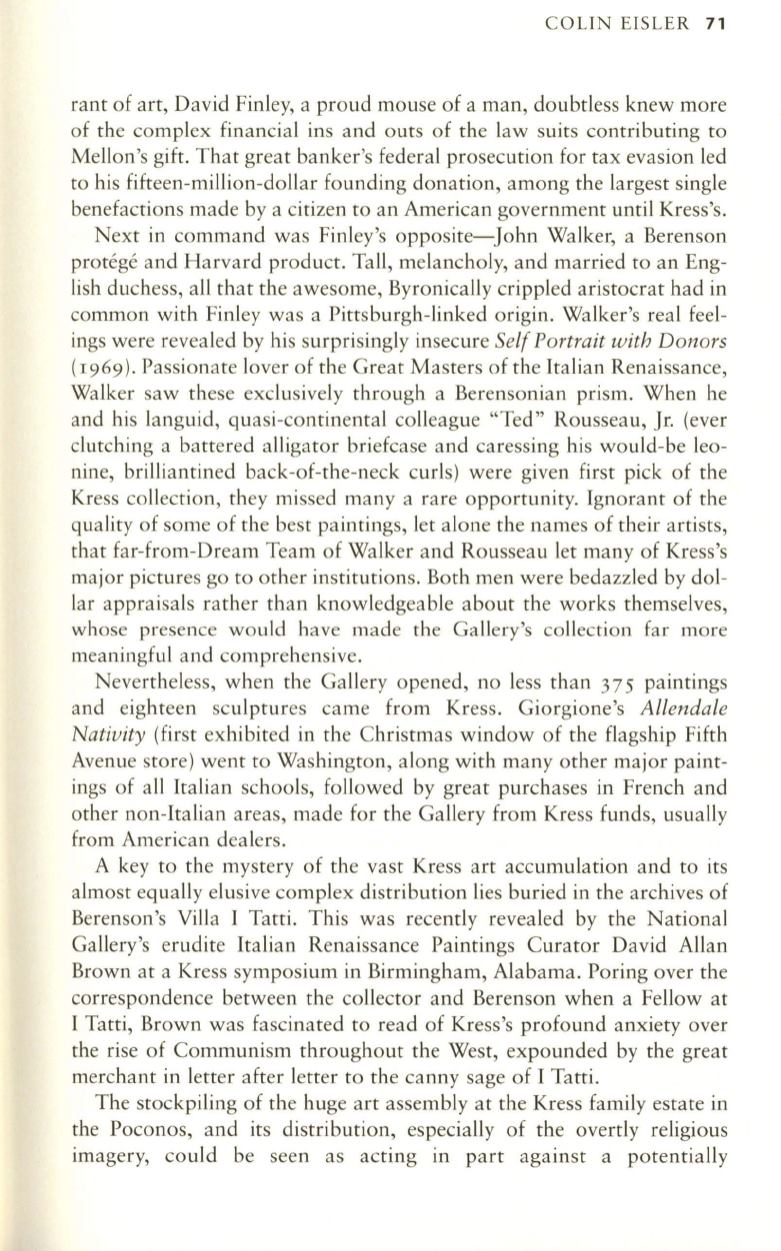
COLIN EISLER
71
rant of art, David Finley, a proud mouse of a man, doubtless knew more
of the complex financial ins and outs of the law suits contributing to
Mellon's gift. That great banker's federal prosecution for tax evasion led
to his fifteen-mill ion-dollar founding donation, among the largest single
benefactions made by a citizen to an American government until Kress's.
Next in command was Finley's opposite-John Walker, a Berenson
protege and Harvard product. Tall, melancholy, and married to an Eng–
lish duchess, all that the awesome, Byronically crippled aristocrat had in
common with Finley was a Pittsburgh-linked origin. Walker's real feel–
ings were revealed by his surprisingly insecure
Self Portrait with Donors
(I969) .
Passionate lover of the Great Masters of the Italian Renaissance,
Walker saw these exclusively through a Berensonian prism. When he
and his languid, quasi-continental colleague "Ted" Rousseau, Jr. (ever
clutching a battered alligator briefcase and caressing his would-be leo–
nine, brilliantined back-of-the-neck curls) were given first pick of the
Kress collection, they missed many a rare opportunity. Ignorant of the
quality of some of the best paintings, let alone the names of their artists,
that far-from-Dream Team of Walker and Rousseau let many of Kress's
major pictures go to other institutions. Both men were bedazzled by dol–
lar appraisals rather than knowledgeable about the works themselves,
whose presence would have made the Gallery's collection far more
meaningful and comprehensive.
Nevertheless, when the Gallery opened, no less than 375 pamtmgs
and eighteen sculptures came from Kress. Giorgione's
Allendale
Nativity
(first exhibited in the Christmas window of the flagship Fifth
Avenue store) went to Washington, along with many other major paint–
ings of all Italian schools, followed by great purchases in French and
other non-Italian areas, made for the Gallery from Kress funds, usually
from American dealers.
A key to the mystery of the vast Kress art accumulation and to its
almost equally elusive complex distribution lies buried in the archives of
Berenson's Villa I Tatti . This was recently revealed by the National
Gallery'S erudite Italian Renaissance Paintings Curator David Allan
Brown at a Kress symposium in Birmingham, Alabama. Poring over the
correspondence between the collector and Berenson when a Fellow at
I Tatti, Brown was fascinated to read of Kress's profound anxiety over
the rise of Communism throughout the West, expounded by the great
merchant in letter after letter to the canny sage of I Tatti.
The stockpiling of the huge art assembly at the Kress family estate in
the Poconos, and its distribution, especially of the overtly religious
imagery, could be seen as acting in part against a potentially


